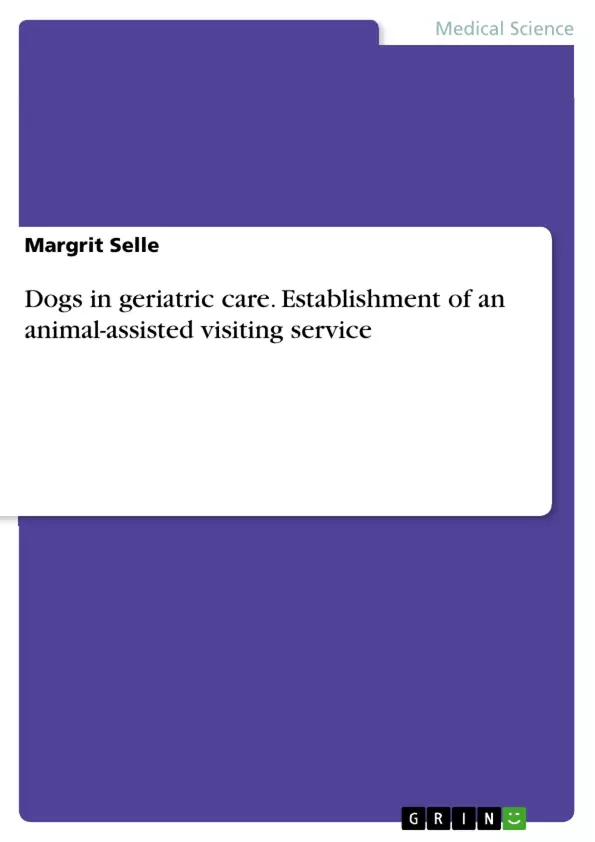Animals have always been people's companions and helpers. They bring life and joy and can also convey quality of life in old age, promote social contacts and protect against isolation. Animals are often a door opener, especially for people suffering from dementia.
These positive effects of animals can also be used in medical, social therapy and nursing areas. In her publication, Margrit Selle explains which requirements must be observed when setting up an animal-assisted visiting service for the elderly.
To this end, Selle examines the relationship between humans and animals as well as the experiences of older people in today's society. It shows what qualities a therapy dog should have and what training can look like. Using practical examples, she makes it clear how a visiting service can be successfully set up.
From the content:
- Dogs;
- Visiting service;
- Senior citizens;
- Dementia;
- Elderly care;
- Therapy
Inhaltsverzeichnis (Table of Contents)
- 1 Introduction
- 1.1 Questions about the present work
- 1.2 Approach and objectives of the work
- 2 Animals as companions of humans
- 2.1 Historical development
- 2.2 Human Animal - Relationship
- 2.3 Effects of animals on humans
- 2.4 Purpose of animal-assisted therapy
- 2.5 State of research
- 3 The elderly in our society
- 3.1 The aging process in Germany
- 3.2 Socialization in old age
- 3.3 Successful and productive aging
- 3.4 The health-impaired senior
- 3.5 Picking up older people where they are
- 3.6 Enduring disabilities with animals
- 4 Basics of a therapy dog team
- 4.1 The Therapy Dog
- 4.2 Forms of interaction and communication between humans and dogs
- 4.3 Holistic therapeutic effect of dogs
- 4.4 Various visiting services
- 4.5 Types of visits
- 4.6 Basic requirements for dog and owner
- 4.7 Training as a visiting dog
- 4.8 Animal Welfare Guidelines
- 4.9 The organization "Animals help people"
- 5 Establishment of a visiting service
- 5.1 Brief market analysis
- 5.2 Requirements for an animal-assisted visiting service
- 5.3 Stress-free animal-assisted work in the sense of the animal
- 5.4 Hygienic cauts
- 5.5 Legal aspects
- 5.6 Relevant insurances
- 5.7 Allowance
- 5.8 Agreements with institutions / individuals
- 5.9 Public relations
- 5.10 Preparations for a dog visit
- 5.11 Visit documentation
- 6 Summary and outlook
Zielsetzung und Themenschwerpunkte (Objectives and Key Themes)
This work explores the establishment of an animal-assisted visiting service for elderly individuals in Germany. The main objective is to provide a comprehensive overview of the benefits of animal-assisted therapy in geriatric care and to outline the practical steps involved in setting up such a service.
- The benefits of animal-assisted therapy for elderly individuals
- The development and application of animal-assisted visiting services
- The legal and ethical considerations involved in animal-assisted therapy
- The role of animal welfare in animal-assisted visiting services
- The practical steps involved in setting up and managing an animal-assisted visiting service
Zusammenfassung der Kapitel (Chapter Summaries)
- Chapter 1: Introduction This chapter sets out the aims of the work, outlining the specific questions that will be addressed and the objectives of the research.
- Chapter 2: Animals as companions of humans This chapter explores the historical development of the human-animal relationship and the various effects of animals on humans. It discusses the role of animals in therapy and the current state of research in this area.
- Chapter 3: The elderly in our society This chapter examines the aging process in Germany and the challenges faced by elderly individuals. It explores issues of socialization, successful aging, and the need to support those with health impairments.
- Chapter 4: Basics of a therapy dog team This chapter delves into the specifics of therapy dog teams, covering the characteristics of a therapy dog, forms of human-dog interaction, and the holistic therapeutic effects of dogs. It also discusses various visiting services, types of visits, and training requirements for visiting dogs.
- Chapter 5: Establishment of a visiting service This chapter outlines the practical steps involved in setting up an animal-assisted visiting service. This includes a market analysis, requirements for the service, ensuring animal welfare, hygienic considerations, legal aspects, insurance needs, agreements with institutions, public relations, and visit preparation and documentation.
Schlüsselwörter (Keywords)
The work focuses on the keywords "animal-assisted therapy," "geriatric care," "visiting service," "animal welfare," and "legal aspects." It explores the potential of animal-assisted therapy to enhance the well-being of elderly individuals and the practical considerations necessary for establishing a successful and ethical service.
- Quote paper
- Margrit Selle (Author), 2018, Dogs in geriatric care. Establishment of an animal-assisted visiting service, Munich, GRIN Verlag, https://www.grin.com/document/1253843



